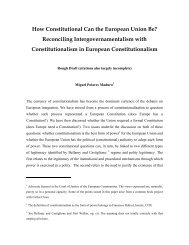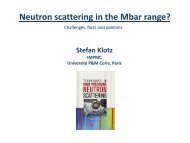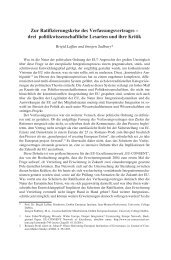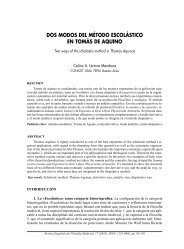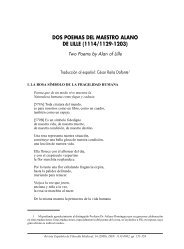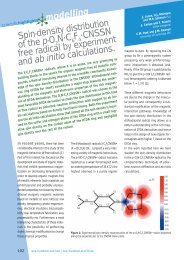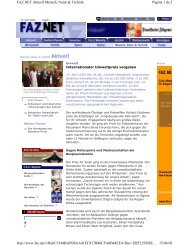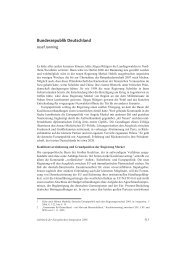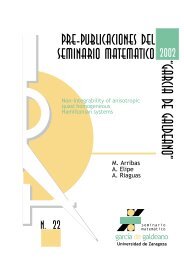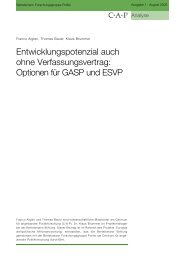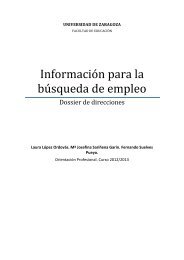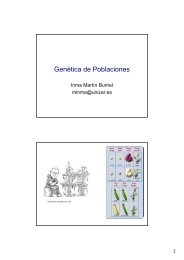giulio racah: the man and his work - Universidad de Zaragoza
giulio racah: the man and his work - Universidad de Zaragoza
giulio racah: the man and his work - Universidad de Zaragoza
Create successful ePaper yourself
Turn your PDF publications into a flip-book with our unique Google optimized e-Paper software.
Monografías <strong>de</strong> la Real Aca<strong>de</strong>mia <strong>de</strong> Ciencias <strong>de</strong> <strong>Zaragoza</strong> 37: 1–6, (2011)<br />
ISSN 1132-6360<br />
GIULIO RACAH: THE MAN AND HIS WORK<br />
ISSACHAR UNNA<br />
Racah Institute of Physics. Hebrew University of Jerusalem<br />
91904 Jerusalem, Israel<br />
Abstract<br />
An introduction to <strong>the</strong> Giulio Racah Centennial Conference. Racah’s life <strong>and</strong><br />
<strong>his</strong> achievements will be presented. Special attention will be <strong>de</strong>voted to Racah’s<br />
contributions to nuclear spectroscopy. Some results induced by <strong>and</strong> obtained with<br />
<strong>his</strong> methods by I. Talmi <strong>and</strong> I. Unna will be presented.<br />
T<strong>his</strong> conference celebrates <strong>the</strong> centennial of Giulio Racah. I am very honored <strong>and</strong> have <strong>the</strong><br />
great pleasure to thank <strong>the</strong> organizers of t<strong>his</strong> conference in t<strong>his</strong> won<strong>de</strong>rful place. In particular,<br />
I want to thank Professor Luis J. Boya <strong>and</strong> <strong>the</strong> RAMON ARECES FOUNDATION. By <strong>the</strong><br />
way, Prof. Boya <strong>and</strong> I are also celebrating <strong>the</strong> Jubilee of our first meeting in ano<strong>the</strong>r beautiful<br />
place. In Varenna, 1960, <strong>the</strong> International summer school “Enrico Fermi” was <strong>de</strong>voted to<br />
“Nuclear Spectroscopy”. Racah was <strong>the</strong> “Direttore <strong>de</strong>l Corso”, Nissan Zel<strong>de</strong>s was <strong>the</strong> “Secretario<br />
Scientifico”. Racah gave <strong>the</strong> course on “Ma<strong>the</strong>matical Techniques”, since, as he said in<br />
<strong>his</strong> opening words, “I am more familiar with <strong>the</strong> ma<strong>the</strong>matics than with <strong>the</strong> physics of nuclear<br />
spectroscopy”. My Thesis adviser <strong>and</strong> Racah’s <strong>de</strong>voted pupil, Igal Talmi, gave “The Nuclear<br />
Shell Mo<strong>de</strong>l”. Igal celebrated now <strong>his</strong> 85th birthday, full of vigour <strong>and</strong> activity. Unfortunately,<br />
he could not come today because he is <strong>the</strong> organizer of a conference at <strong>the</strong> Weiz<strong>man</strong>n Institute<br />
at exactly <strong>the</strong> same dates.<br />
The opening of <strong>the</strong> Hebrew University took place in 1925. At about <strong>the</strong> same time Quantum<br />
Mechanics was born.<br />
For fifteen years, since its opening, <strong>the</strong> Hebrew University was <strong>de</strong>sperately looking for a good<br />
<strong>the</strong>oretical physicist whowas ready to teach <strong>and</strong> do research in it. Albert Einstein was consulted<br />
on an almost daily basis. Several giants were seriously approached <strong>and</strong> on <strong>the</strong> verge of agreements,<br />
like George Placzek, Felix Bloch, Fritz London <strong>and</strong> Eugene Wigner. All <strong>the</strong>se efforts<br />
failed.<br />
1
All <strong>the</strong>se fifteen years Quantum Mechanics, with all its successes, was completely impotent in<br />
<strong>de</strong>aling with atoms having more than 2 active electrons, which meant that most atomic spectra<br />
could not be explained with <strong>the</strong> new <strong>the</strong>ory.<br />
Then appeared Racah, a bright young physicist (age 30) from Italy, full of <strong>the</strong>oretical vigour,<br />
<strong>and</strong> a <strong>de</strong>termined Zionist, <strong>and</strong> filled <strong>the</strong> empty position at <strong>the</strong> Hebrew University as well as <strong>the</strong><br />
existing void in Quantum Mechanics, like <strong>the</strong> last missing piece in a jigsaw puzzle completing<br />
<strong>the</strong> picture in all directions. Racah arrived at <strong>the</strong> Hebrew University in 1940 (after <strong>the</strong> outbreak<br />
of WWII). He had excellent reference letters by <strong>his</strong> beloved teacher, Enrico Fermi, <strong>and</strong> also by<br />
Wolfgang Pauli, Niels Bohr, Kramers <strong>and</strong> Fritz London. Fermi wrote:<br />
“Of <strong>the</strong> cadidates you mentioned I can provi<strong>de</strong> information only on Prof. Racah. I knew him<br />
very well... he <strong>work</strong>ed with me for some time in Rome. I could <strong>the</strong>refore appreciate [<strong>his</strong>] really<br />
outst<strong>and</strong>ing knowledge of physics, <strong>and</strong> follow very closely <strong>his</strong> interest in scientific <strong>work</strong>. His<br />
contributions to <strong>the</strong> quantum <strong>the</strong>ory of radiation are particularly valuable. I have to mention<br />
that he arrived in<strong>de</strong>pen<strong>de</strong>ntly <strong>and</strong> almost simultaneously with Be<strong>the</strong> <strong>and</strong> Heitler at <strong>the</strong> same<br />
results concerning <strong>the</strong> emission of radiation by high-energy electrons. May I be allowed to add,<br />
that in my opinion Racah possesses all <strong>the</strong> personal attributes to lead most effectively young<br />
stu<strong>de</strong>nts in scientific <strong>work</strong>.”<br />
(Fermi, 8 September 1939)<br />
In 1951 Racah writes from Princeton to <strong>the</strong> rector of <strong>the</strong> Hebrew University:<br />
“I went to visit my Rebbe - Fermi. I did not write so far because I was busy with discussions<br />
(<strong>and</strong> small talk). After all, <strong>the</strong>se were <strong>the</strong> main purpose of my trip. Doing <strong>work</strong> I can much<br />
better at home in Jerusalem, at least late at night when <strong>the</strong>re are no committee meetings...”<br />
(Racah, 29 January 1951)<br />
Pauli wrote:<br />
“I know him personally, <strong>and</strong> know <strong>his</strong> <strong>work</strong>s well. An extraordinary ma<strong>the</strong>matical talent,<br />
<strong>and</strong> in perfect com<strong>man</strong>d in any problems <strong>and</strong> methods of mo<strong>de</strong>rn <strong>the</strong>oretical physics (wave<br />
mechanics <strong>and</strong> quantum electrodynamics) .... He succee<strong>de</strong>d in solving problems which <strong>de</strong>terred<br />
o<strong>the</strong>rs (<strong>the</strong> creation of pairs as a result of <strong>the</strong> collision of fast charged particles with atoms, <strong>and</strong><br />
also <strong>the</strong> computation of <strong>the</strong> radiation of very fast particles ...) problems which are at <strong>the</strong> core<br />
of <strong>the</strong> most mo<strong>de</strong>rn <strong>the</strong>ories of cosmic rays . . . <strong>and</strong> <strong>the</strong>refore he is qualified also to cooperate<br />
with an experimental research institute. He is also extraordinarily conversant with questions<br />
of principle .... In conclusion, I do not know a c<strong>and</strong>idate more suitable for a professorship in<br />
<strong>the</strong>oretical physics in Jerusalem than Prof. Racah. As regards [Reinhold] Furth (Prague) [who<br />
also was un<strong>de</strong>r consi<strong>de</strong>ration], he is undoubtedly a good crafts<strong>man</strong> particularly in <strong>the</strong> area of<br />
Brownian motion, but he is less original, <strong>and</strong> of weaker attitu<strong>de</strong> to mo<strong>de</strong>rn physics.”<br />
When Racah arrived in Jerusalem in 1940 he had to cope with a new country, new culture, new<br />
language, <strong>and</strong> with complete scientific isolation. Yet, he called <strong>the</strong> year 1940 “The best year<br />
of my life”. During t<strong>his</strong> year he learned perfect Hebrew [but even speaking Hebrew he never<br />
lost <strong>his</strong> heavy musical Florentine accent], he married <strong>his</strong> loving girl Zmira Mani, daughter of a<br />
2
well rooted Jewish-Palestinian family <strong>and</strong> he wrote <strong>his</strong> first paper, of <strong>the</strong> famous four, on <strong>the</strong><br />
“Theory of Complex Spectra”.<br />
The <strong>work</strong> on <strong>the</strong>se papers was accomplished in complete seclusion from <strong>the</strong> scientific world. And<br />
<strong>the</strong>se papers ma<strong>de</strong> <strong>his</strong> fame. They contain what is now known as <strong>the</strong> “Racah Algebra”. The<br />
second paper was inclu<strong>de</strong>d in <strong>the</strong> “Physical Review Centennial Volume” (1995), which contains<br />
<strong>the</strong> 200 most important articles in a hundred years. Racah’s papers were also on <strong>the</strong> short list<br />
of <strong>the</strong> most cited papers in <strong>the</strong> 1950s. Hans Be<strong>the</strong> in a review of <strong>the</strong> centennial volume writes:<br />
“The paper by Giulio Racah [“Theory of Complex Spectra”] gives everything <strong>the</strong> <strong>the</strong>orist<br />
needs to <strong>work</strong> on <strong>the</strong> subject.”<br />
The content of <strong>the</strong>se papers is now part <strong>and</strong> parcel of every advanced textbook in Quantum<br />
Theory. Racah was a prominent figure, very dynamic <strong>and</strong> full of vigour. Each of <strong>his</strong> classes, or<br />
even an eventual conversation in <strong>the</strong> corridor (never gossip or nonesense) was an unforgettable<br />
experience. He was an excellent teacher. I had <strong>the</strong> great privilege to aquire <strong>the</strong> whole base<br />
of physics – classic <strong>and</strong> mo<strong>de</strong>rn – from him in <strong>his</strong> courses. Beginning with classical mechanics<br />
<strong>and</strong> electrodynamics, ending with QED, atomic spectroscopy <strong>and</strong> nuclear physics. The most<br />
<strong>de</strong>voted pupil <strong>and</strong> assistant of Racah was Nissan Zel<strong>de</strong>s, who was invited to give t<strong>his</strong> talk,<br />
but was, unfotunately, unable to come. He published recently a big article in <strong>the</strong> “Archive for<br />
<strong>the</strong> History of Exact Sciences” [63, 289-323, (2009)]: “Giulio Racah <strong>and</strong> Theoretical Physics<br />
in Jerusalem” [I helped with <strong>the</strong> final editing of it]. Ano<strong>the</strong>r relevant reference is my paper in<br />
“Physics in Perspective” [2, 336-380, (2000)] : “The Genesis of Physics at <strong>the</strong> Hebrew University<br />
of Jerusalem”.<br />
My <strong>the</strong>sis advisers were Igal Talmi <strong>and</strong> <strong>the</strong> late Amos <strong>de</strong>-Shalit, <strong>his</strong> world known pupils. But<br />
<strong>the</strong>y were at <strong>the</strong> Weiz<strong>man</strong>n Institute, Rehovoth, <strong>and</strong> I was still studying in Jerusalem. So I went<br />
toget advisefromRacah whenever Igot stuck withmycalculations innuclear shell <strong>the</strong>ory. Later<br />
I learned that my questions motivated Racah to fur<strong>the</strong>r <strong>de</strong>velopments of <strong>his</strong> <strong>the</strong>ory in nuclear<br />
spectroscopy.<br />
I shall not forget our excitement as stu<strong>de</strong>nts before each of <strong>his</strong> lectures. We were fighting for<br />
good seats in <strong>the</strong> lecture hall. In<strong>de</strong>ed, <strong>the</strong> lectures were masterpieces of clarity in content <strong>and</strong><br />
presentation. With typical stubbornness he insisted on carrying out each calculation from start<br />
all through to <strong>the</strong> final results. The complicated expressions were written in perfect or<strong>de</strong>r,<br />
line after line, on <strong>the</strong> big blackboard. It could be <strong>the</strong> form of a hanging chain in classical<br />
mechanics, <strong>the</strong> <strong>de</strong>tailed solution of a differential equation in quantum mechanics or calculating<br />
<strong>the</strong> refraction coefficients of light directly from Maxwell’s equations. He did not omit any stage<br />
of <strong>the</strong> calculation. It was never “it easy to see” or “you can easily verify”<br />
When he published <strong>his</strong> book toge<strong>the</strong>r with <strong>his</strong> cousin Hugo Fano, “Irreducible Tensorial Sets”,<br />
he told me that he <strong>and</strong> Fano had lots of fights over <strong>the</strong> book. I asked him why. He answered<br />
that “The reason was that we had a common gr<strong>and</strong>mo<strong>the</strong>r who was very stubborn”<br />
In<strong>de</strong>ed, stubbornness was a typical virtue of Racah, in <strong>the</strong> good sense of it. When he <strong>de</strong>ci<strong>de</strong>d<br />
to carry out a calculation - nothing could stop him, even if it turned out to be very lengthy <strong>and</strong><br />
3
extremely complicated. That is how he succee<strong>de</strong>d in calculating <strong>his</strong> coefficients <strong>and</strong> <strong>de</strong>veloping<br />
<strong>his</strong> algebra during long lonely nights.<br />
Racah was a good friend with us, stu<strong>de</strong>nts, <strong>and</strong> showed <strong>his</strong> friendliness in so <strong>man</strong>y ways. I<br />
remember, in particular, traveling with him, in <strong>his</strong> car from Jerusalem to seminars in Rehovoth.<br />
He invited us to join him <strong>and</strong> we felt honored <strong>and</strong> excited. During <strong>the</strong> trip we had lengthy<br />
talks, usually on scientific subjects. When he got excited during a discussion he would talk with<br />
both <strong>his</strong> h<strong>and</strong>s in <strong>the</strong> air, <strong>and</strong> we trembled till <strong>his</strong> h<strong>and</strong>s returned to hold <strong>the</strong> steering wheel.<br />
He showed high involvement in our stu<strong>de</strong>nts’ life. He joined us in parties <strong>and</strong> volunteered with<br />
us in going to <strong>the</strong> country to build fortifications around isolated settlements. He arrived in a<br />
labourer’s shirt, shorts <strong>and</strong> a big sun hat <strong>and</strong> was amongst <strong>the</strong> best <strong>work</strong>ers out <strong>the</strong>re. From<br />
time to time we could hear talks on better angular momenta coupling mo<strong>de</strong>s or new checks of<br />
matrix diagonalization programs coming out from one of <strong>the</strong> <strong>de</strong>ep ditches, accompanied by <strong>the</strong><br />
sounds of digging ploughs <strong>and</strong> spa<strong>de</strong>s.<br />
A few years before <strong>his</strong> untimely <strong>de</strong>ath he had a car acci<strong>de</strong>nt on <strong>his</strong> way to Eilath. Talking about<br />
it, he said he has an acci<strong>de</strong>nt once every 20 years. He is glad he survived t<strong>his</strong> one unhurt. Next<br />
time he will be old so he has nothing to be afraid of. It seems, t<strong>his</strong> was <strong>his</strong> greatest mistake.<br />
At <strong>the</strong> age of 56 an acci<strong>de</strong>nt of a different kind took <strong>his</strong> life when he was still full of vigour <strong>and</strong><br />
abounding with plans.<br />
Five years after <strong>his</strong> <strong>de</strong>ath <strong>the</strong> “Racah Institute of Physics” was established at <strong>the</strong> Hebrew<br />
University. In <strong>the</strong> same year a crater on <strong>the</strong> moon was officially named after him. In 1993 <strong>the</strong><br />
State of Israel issued a post stamp with <strong>his</strong> portrait. Streets in Jerusalem <strong>and</strong> Beer-Sheva carry<br />
<strong>his</strong> name.<br />
Racah is also remembered for <strong>man</strong>y public activities at <strong>the</strong> Hebrew University,as well as nationwi<strong>de</strong><br />
<strong>and</strong> international. Let me mention a few. He was member of commissions on st<strong>and</strong>ards<br />
<strong>and</strong> spectra by <strong>the</strong> International Astronomical Union, <strong>and</strong> IUPAP (later also IUPAC). The Joint<br />
Commission for Spectroscopy set Jerusalem as <strong>the</strong> clearing house for angular wave functions,<br />
giving all <strong>the</strong> information on <strong>the</strong> related calculations carried out worldwi<strong>de</strong> so as to prevent<br />
overlapping activities. Thus, <strong>the</strong> <strong>the</strong>oretical physics <strong>de</strong>partment in Jerusalem became a world<br />
center for atomic spectroscopy. In <strong>his</strong> last years (1961-1965) Racah served as Rector <strong>and</strong> Presi<strong>de</strong>nt<br />
of <strong>the</strong> Hebrew University. In t<strong>his</strong> position he promoted <strong>the</strong> teaching of courses for stu<strong>de</strong>nts<br />
from African <strong>and</strong> Asian countries. He had <strong>the</strong> privilege to convocate a honorary <strong>de</strong>gree on Haim<br />
Weiz<strong>man</strong>n, <strong>the</strong> big Zionist lea<strong>de</strong>r, foun<strong>de</strong>r of <strong>the</strong> Hebrew University <strong>and</strong> <strong>the</strong> first Peresi<strong>de</strong>nt of<br />
<strong>the</strong> State of Israel. Later he honored Felix Bloch with <strong>the</strong> Honorary Degree of <strong>the</strong> University.<br />
He was amongst <strong>the</strong> foun<strong>de</strong>rs of <strong>the</strong> Israel Aca<strong>de</strong>my of Sciences (1959). He served as member<br />
of <strong>the</strong> Scientific Council to <strong>the</strong> Prime Minister (later - <strong>the</strong> National Counsil for Research <strong>and</strong><br />
Development) <strong>and</strong> was a member of Israel’s Atomic Energy Commission. As such, he served as<br />
<strong>de</strong>legate to <strong>the</strong> Geneva International Conferences on <strong>the</strong> peaceful uses of atomic energy.<br />
In1961hewasconvocated DoctorHonorisofManchesterUniversity. Theceremonytookplaceat<br />
<strong>the</strong>Ru<strong>the</strong>rfordJubileeInternational Conference(celebrating 50yearstoRu<strong>the</strong>rford’sdiscovery).<br />
4
I was fortunate to attend it. Many of <strong>the</strong> greatest physicists were <strong>the</strong>re. Niels Bohr, Dirac,<br />
Peierls, Aage Bohr, Mottelson etc. I remember Niels Bohr, dressed with big blue garter of <strong>the</strong><br />
“Or<strong>de</strong>r of <strong>the</strong> Elephant” dancing at <strong>the</strong> evening party. Racah received <strong>man</strong>y honors <strong>and</strong> prizes<br />
during <strong>his</strong> aca<strong>de</strong>mic life including <strong>the</strong> prestigious Israel Prize.<br />
As mentioned, Racah applied most of <strong>his</strong> ma<strong>the</strong>matical methods to atomic spectra. He felt that<br />
<strong>the</strong>re were not enough nuclear spectroscopic data available for reliable calculations. But <strong>his</strong><br />
interest <strong>and</strong> <strong>the</strong>oretical i<strong>de</strong>as were gradually shifting to <strong>the</strong> nuclear regime. The establishment<br />
of <strong>the</strong> nuclear shell mo<strong>de</strong>l was a crucial step <strong>and</strong> motivated <strong>his</strong> i<strong>de</strong>as. His stu<strong>de</strong>nts Zel<strong>de</strong>s,<br />
<strong>de</strong>-Shalit, Talmi <strong>and</strong> o<strong>the</strong>rs took over <strong>the</strong> torch into <strong>the</strong> nuclear spectroscopy. Zel<strong>de</strong>s specialized<br />
in nuclear masses. He <strong>and</strong> <strong>the</strong> o<strong>the</strong>rs took shell mo<strong>de</strong>l calculations to <strong>the</strong>ir real great sucesses.<br />
T<strong>his</strong> was <strong>the</strong> time when I entered <strong>the</strong> scene (1958).<br />
In <strong>the</strong> year 1944 Racah gave <strong>the</strong> major talk at <strong>the</strong> Israel Chemists Organisation. The title<br />
was: “Introduction to Nuclear Theory”. At <strong>the</strong> end of <strong>his</strong> talk he said: “ If it is true that new<br />
neutrons are emitted upon <strong>the</strong> explosion of Uranium induced by neutrons <strong>the</strong>n we might obtain<br />
a chain reaction. If t<strong>his</strong> was achieved I do not know, since from <strong>the</strong> beginning of <strong>the</strong> war t<strong>his</strong><br />
kind of information is kept secret” . He <strong>the</strong>n spoke about <strong>the</strong> difference between slow <strong>and</strong> fast<br />
neutrons <strong>and</strong> <strong>the</strong> possible necessity of separating <strong>the</strong> U235 component. “But”, he en<strong>de</strong>d, “we<br />
shall have to wait till <strong>the</strong> end of <strong>the</strong> war to know where <strong>the</strong> nuclear science st<strong>and</strong>s.”<br />
On <strong>the</strong> 18th December 1945 he gave again a talk at <strong>the</strong> same forum: “New Developments in<br />
Nuclear Theory”. T<strong>his</strong> talk was post Hiroshima <strong>and</strong> it <strong>de</strong>alt with <strong>the</strong> new knowledge attained<br />
(”although, a lot is still kept secret”, as he said). Ten years later I atten<strong>de</strong>d <strong>the</strong> course on<br />
Nuclear Theory given by Racah for a whole semester. But <strong>his</strong> ma<strong>the</strong>matical methods I learned<br />
in <strong>his</strong> course on Atomic Spectroscopy as well as by attending <strong>his</strong> seminar on Selected Topics in<br />
Atomic Spectroscopy. Here I discovered how much we can achieve in analysing spectra without<br />
making <strong>de</strong>tailed assumptions on <strong>the</strong> form of <strong>the</strong> interaction. Actually, t<strong>his</strong> is exactly what <strong>the</strong><br />
Racah Algebra helps us do. In <strong>his</strong> atomic calculations <strong>the</strong> few Radial integrals are kept as<br />
parameters <strong>and</strong> <strong>the</strong> quantum predictions are ma<strong>de</strong> purely by applying Racah’s algebraic <strong>and</strong><br />
group <strong>the</strong>oretic methods to <strong>the</strong> angular parts of <strong>the</strong> wave functions.<br />
These methods become even more important in nuclear spectroscopy where <strong>the</strong> basic interaction<br />
is unknown a priori. The assumptions we make in our caculations are minimal. All we assume<br />
is that <strong>the</strong> nuclear interaction is a two body interaction, <strong>and</strong> that it does not change with <strong>the</strong><br />
addition of nucleons so long as we are confined to a single nuclear shell. Thus, we could use<br />
<strong>the</strong> two particle spectra, applying Racah’s methods to calculate <strong>the</strong> spectra of n particles in <strong>the</strong><br />
same open shell.<br />
Some of Racah’s inventions for efficient atomic calculations are even more spectacular in <strong>the</strong><br />
nuclear context. In paticular, <strong>the</strong> concept of <strong>the</strong> seniority quantum number <strong>and</strong> <strong>the</strong> use of<br />
sop<strong>his</strong>ticated Lie groups for <strong>the</strong> analysis of nuclear spectra. The seniority is first introduced in<br />
<strong>his</strong> TCS III paper (1943). Explicit use of group <strong>the</strong>ory appears first in TCS IV (1949), where<br />
Racah caculated f n configurations. In t<strong>his</strong> paper he also proves a very useful lemma. A much<br />
5
more systematic exposition of Lie groups <strong>and</strong> <strong>the</strong>ir application to spectroscopy was given in a<br />
set of lectures <strong>de</strong>livered in 1951 at <strong>the</strong> Institute for Advanced Study in Princeton. [here, Racah<br />
also met Albert Einstein for <strong>the</strong> first time.]. These important lectures were written as notes by<br />
Eugen Merzbacher <strong>and</strong> David Pank. For years <strong>the</strong>se notes were so hard to get that <strong>the</strong>y almost<br />
became collectors’ items. Ten years later, by a lucky chance, a copy was uncovered in CERN.<br />
With Racah’s permission <strong>the</strong>y mimeographed it for <strong>the</strong> benefit of a wi<strong>de</strong>r audience. Later <strong>the</strong><br />
notes appeared as a book in <strong>the</strong> Springer Lecture Notes series.<br />
In a small <strong>and</strong> quite unknown paper [L.Farkas Memorial Volume, Research Council of Israel, 1,<br />
294-304 (1952)] Racah transferes <strong>his</strong> methods specifically to nuclear jj-coupling spectra. Here,<br />
as it turns out one has to use <strong>the</strong> Symplectic group instead of <strong>the</strong> Orthogonal group. T<strong>his</strong> group<br />
was first introduced by Her<strong>man</strong> Weyl in <strong>his</strong> Classical Groups (Princeton, 1938). T<strong>his</strong> group<br />
leaves a skew- symmetric bilinear form invariant. T<strong>his</strong> is necessary because <strong>the</strong> scalar two-body<br />
wave function, <strong>the</strong> j 2 (J = 0) is antisymmetric contrary to <strong>the</strong> l 2 (L = 0) case. T<strong>his</strong> group<br />
gave a very efficient tool in calculating j n spectra. We (Igal Talmi <strong>and</strong> myself) were able to<br />
obtain some excellent fits with experimental data. The first good case was <strong>the</strong> binding energies<br />
of nuclei with 1f 7/2<br />
n configurations (neutrons or protons) [I. Talmi, Phys. Rev. 107, 326 (1957)].<br />
Even more exciting was a result we obtained for 11 Be. Using <strong>the</strong> <strong>the</strong> simplest Racah methods<br />
we confirmed its positive parity ground state, which was contrary to what everyone believed<br />
[I. Talmi <strong>and</strong> I. Unna, Phys. Rev. Letters, 4, 469 (1960)]. In spite of its apparent simplicity,<br />
t<strong>his</strong> was an exact shell mo<strong>de</strong>l calculation. Good reviews of <strong>the</strong> methods <strong>and</strong> of our results can<br />
be found in: I. Talmi <strong>and</strong> I. Unna, Annual Rev. Nuclear Sci., 10, 353 (1960) <strong>and</strong> I. Talmi,<br />
Revs. Mod. Phys., 34, 704 (1962). The latter summarizes <strong>man</strong>y of my early <strong>work</strong>s on nuclear<br />
spectroscopy.<br />
Later, I did some basic <strong>work</strong> on applying BCS , RPA, second RPA <strong>and</strong> HF to nuclei <strong>and</strong> <strong>de</strong>aling<br />
with <strong>the</strong> eliminations of spurious states [see, for example, Spectroscopic <strong>and</strong> Group Theoretical<br />
Methods in Physics, Racah Memorial Volume, edited by F.Bloch / S. G. Cohen / A. De-Shalit<br />
/ S. Sambursky / I. Talmi (Notrth Holl<strong>and</strong> 1968), p. 403]. Now, I do <strong>his</strong>tory – mainly <strong>work</strong>ing<br />
with <strong>the</strong> huge editorial project of editing <strong>the</strong> writings of Einstein, <strong>the</strong> EPP, Caltech, Pasa<strong>de</strong>na,<br />
<strong>and</strong>, believe me, <strong>work</strong>ing on Einstein’s correspon<strong>de</strong>nce <strong>and</strong> unpublished material we make a lot<br />
of exciting discoveries.<br />
Thank you!.<br />
6



